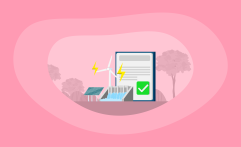Carbon Avoidance Offsets Explained: All You Need to Know
Impactful Ninja is reader-supported. When you buy through links on our site, we may earn an affiliate commission.
Learn more
Learn more
.
Hey fellow impactful ninja ? You may have noticed that Impactful Ninja is all about providing helpful information to make a positive impact on the world and society. And that we love to link back to where we found all the information for each of our posts. Most of these links are informational-based for you to check out their primary sources with one click. But some of these links are so-called "affiliate links" to products that we recommend. First and foremost, because we believe that they add value to you. For example, when we wrote a post about the environmental impact of long showers, we came across an EPA recommendation to use WaterSense showerheads. So we linked to where you can find them. Or, for many of our posts, we also link to our favorite books on that topic so that you can get a much more holistic overview than one single blog post could provide. And when there is an affiliate program for these products, we sign up for it. For example, as Amazon Associates, we earn from qualifying purchases. First, and most importantly, we still only recommend products that we believe add value for you. When you buy something through one of our affiliate links, we may earn a small commission - but at no additional costs to you. And when you buy something through a link that is not an affiliate link, we won’t receive any commission but we’ll still be happy to have helped you. When we find products that we believe add value to you and the seller has an affiliate program, we sign up for it. When you buy something through one of our affiliate links, we may earn a small commission (at no extra costs to you). And at this point in time, all money is reinvested in sharing the most helpful content with you. This includes all operating costs for running this site and the content creation itself. You may have noticed by the way Impactful Ninja is operated that money is not the driving factor behind it. It is a passion project of mine and I love to share helpful information with you to make a positive impact on the world and society. However, it's a project in that I invest a lot of time and also quite some money. Eventually, my dream is to one day turn this passion project into my full-time job and provide even more helpful information. But that's still a long time to go. Stay impactful,Affiliate Disclosure
Why do we add these product links?
What do these affiliate links mean for you?
What do these affiliate links mean for us?
What does this mean for me personally?
![]()
One way to reduce human-derived atmospheric carbon dioxide (CO2) emissions is via carbon avoidance, or methods that prevent the release of CO2 into our atmosphere. If partnered with carbon offsets, carbon avoidance could have a greater impact. So, we had to ask: What are carbon avoidance offsets really, and could they help us mitigate climate change?
Carbon avoidance offsets are a specific type of carbon offset that focuses on preventing carbon emissions from entering our atmosphere. Avoidance projects reduce CO2 emissions by supporting projects that protect existing carbon sinks, reduce pollution, and foster the switch to renewable energy.
Keep reading to find out all about what carbon avoidance offsets are, how they work, how effective and efficient they are, what their pros and cons are, and what the best ones are. At the end of the article, we’ll also share with you how carbon avoidance offsets can help mitigate climate change and what better alternatives to them are.
The Big Picture of Carbon Avoidance Offsets
Carbon offsets are reductions in carbon emissions that are used to compensate for carbon emissions occurring elsewhere. They are measured in tons of carbon dioxide (CO2) equivalents and are bought and sold through international brokers, online retailers, and trading platforms on what is known as the global carbon offset market.
“Carbon Offset: a way for a company or person to reduce the level of carbon dioxide for which they are responsible by paying money to a company that works to reduce the total amount produced in the world, for example by reforestation”
Oxford Dictionary
Carbon avoidance is the prevention of future carbon emissions via particular carbon offsets or via direct carbon reduction measures. It is one form of carbon reduction,
“Avoidance: not doing something; preventing something from existing or happening”
Oxford Dictionary
Purchasing carbon avoidance offsets funds carbon emission reduction projects that prevent CO2 from entering the atmosphere. It is a proactive, rather than a reactive, way of dealing with carbon emissions.
| What are carbon avoidance offsets | Carbon avoidance offsets are a specific type of carbon offset that focuses on preventing carbon emissions from entering our atmosphere. |
| How do carbon avoidance offsets work | Purchasing carbon avoidance offsets funds carbon emission reduction projects that prevent CO2 from entering the atmosphere in the future. It is a proactive, rather than a reactive, way of dealing with carbon emissions. |
| How effective and efficient are carbon avoidance offsets | Effectiveness: Depending on the type of avoidance, carbon avoidance offsets can help reduce deforestation and strengthen our natural carbon sinks, reduce methane emissions and other forms of pollution, bolster energy security, and help transition away from fossil fuels. However, they can also lack additionality and do not reduce your own carbon emissions. Efficiency: Depending on the type of avoidance, carbon avoidance offsets can be proactive and relatively cost-effective; however, they can also be difficult to monitor and verify and they are not yet scaled to compensate for our global emissions. |
| What are the 6 pros of carbon avoidance offsets | 1. Carbon avoidance offsets are proactive 2. Carbon avoidance offsets can protect existing carbon sinks 3. Carbon avoidance offsets can be relatively cost-effective 4. Carbon avoidance offsets can bolster energy security and help transition away from fossil fuels 5. Carbon avoidance offsets can reduce methane emissions and other forms of pollution 6. Carbon avoidance offsets allow us to reduce carbon emissions in ways we wouldn’t be able to accomplish individually |
| What are the 4 cons of carbon avoidance offsets | 1. Carbon avoidance offsets can lack additionality 2. Carbon avoidance offsets can lack standardization and monitoring 3. Carbon avoidance offsets are not yet scaled to compensate for our global waste emissions 4. Carbon avoidance offsets do not reduce your own carbon emissions, which can lead to greenwashing |
| What are the best carbon avoidance offsets | The best carbon avoidance offsets are offered by Terrapass, Native Energy, Carbonfund, and Ecologi which offer REDD+, waste management, energy efficiency, or certain types of agricultural offsets. In addition, REDD.plus, CoreZero, and Del Agua specialize in specific avoidance offsets. |
What Are Carbon Avoidance Offsets
Carbon avoidance is the prevention of future carbon emissions via particular carbon offsets or via direct carbon reduction measures. It is one form of carbon reduction,
“Avoidance: not doing something; preventing something from existing or happening”
Oxford Dictionary
Carbon offsets that are commonly classified as carbon avoidance measures include:
- Reducing Emissions from Deforestation and Forest Degradation (REDD+)
- Waste Management
- Energy efficiency
- Agriculture
How Do Carbon Avoidance Offsets Work
Purchasing carbon avoidance offsets funds carbon emission reduction projects that prevent CO2 from entering the atmosphere. It is a proactive, rather than a reactive, way of dealing with carbon emissions.
For example, carbon avoidance projects such as REDD+ can help protect existing carbon sinks (e.g., via avoided deforestation). And projects such as landfill gas capture and conversion to renewable energy can prevent methane (CH4) emissions from entering our atmosphere. These types of projects can buy us time to implement permanent carbon reduction measures such as direct carbon capture.
How Effective and Efficient Are Carbon Avoidance Offsets
In terms of effectiveness, carbon avoidance offsets can help reduce deforestation and strengthen our natural carbon sinks, reduce methane emissions and other forms of pollution, bolster energy security, and help transition away from fossil fuels. However, they can lack additionality and they do not reduce your own carbon emissions, which can lead to greenwashing.
In terms of efficiency, carbon avoidance offsets are proactive and relatively cost-effective; however, they can also be difficult to monitor and verify and they are not yet scaled to compensate for our global emissions.
Carbon avoidance offsets are effective at mitigating climate change because:
- Carbon avoidance offsets involving REDD+, energy efficiency, and agriculture protect forest and grassland ecosystems and their ability to act as carbon sinks.
- Carbon avoidance offsets involving waste management, energy efficiency, and agriculture reduce methane (CH4) emissions and combat land, air, and water pollution.
- Carbon avoidance offsets involving waste management and energy efficiency can help reduce reliance on biomass and fossil fuels, leading to increased energy security and energy independence.
However, carbon avoidance offsets involving REDD+, waste management, and energy efficiency can also lack additionality due to uncertainty in determining baselines and increasing demand for projects.
Carbon avoidance offsets are efficient at reducing CO2 emissions because:
- Carbon avoidance offsets cut emissions at their source, making them a proactive way of dealing with emissions.
- Carbon avoidance offsets involving REDD+, waste management, energy efficiency, and agriculture are some of the most cost-effective methods of carbon emission reduction.
However, carbon avoidance offsets can also lack efficiency because:
- The decentralized nature and many different types of energy-efficiency and agricultural carbon avoidance offsets can make standardization and monitoring difficult.
- Waste management and agricultural carbon avoidance offsets are not yet scaled to compensate for the billions of tons of greenhouse gasses (GHGs) we emit annually.
In addition, carbon avoidance offsets do not reduce your own carbon emissions, which can lead to greenwashing. This occurs when emissions are only offset and not reduced from the source, and the consumer is deceived into thinking they are offsetting their emissions but in reality, they are not. This is why we should first reduce our emissions before relying on offsets.
What Are The 6 Pros and 4 Cons of Carbon Avoidance Offsets
Carbon avoidance offsets are a proactive, relatively cost-effective way of dealing with CO2 emissions that can protect existing carbon sinks, bolster energy security, help transition away from fossil fuels, and reduce various forms of pollution. Carbon avoidance offsets also allow us to reduce carbon emissions in ways we wouldn’t be able to accomplish individually.
Carbon avoidance offsets can lack additionality, standardization, and monitoring, and are not yet scaled to compensate for our global waste emissions. They also do not reduce your own carbon emissions, which can lead to greenwashing.
What Are the 6 Pros of Carbon Avoidance Offsets
Carbon avoidance offsets have various pros that make them effective at proactively reducing carbon emissions.
| Pros of Carbon Avoidance Offsets | Quick Facts |
| #1: Carbon avoidance offsets are proactive | Carbon avoidance is a proactive, rather than reactive, way of dealing with emissions. By eliminating emissions at the source, we cut down on fossil fuel (e.g., coal, oil, and natural gas) usage. |
| #2: Carbon avoidance offsets can protect existing carbon sinks | Carbon avoidance offsets involving REDD+, energy efficiency, and agriculture protect forest and grassland ecosystems and their ability to act as carbon sinks. |
| #3: Carbon avoidance offsets can be relatively cost-effective | REDD+, waste management, energy efficiency, and agricultural carbon offsets are some of the most cost-effective methods of carbon emission reduction. |
| #4: Carbon avoidance offsets can bolster energy security and help transition away from fossil fuels | Waste management and energy-efficiency projects reduce overall energy demand, which in turn reduces reliance on imports of biomass fuels or fossil fuels. Being able to produce your own energy without relying on other entities increases energy security, and increased energy security fosters energy independence. |
| #5: Carbon avoidance offsets can reduce methane emissions and other forms of pollution | Waste management and farm power agricultural offsets can reduce CH4 emissions via CH4 capture, combustion, or conversion to energy projects. They can also target land, air, or water pollution, depending on the project. |
| #6: Carbon avoidance offsets allow us to reduce carbon emissions in ways we wouldn’t be able to accomplish individually | Carbon avoidance offsets allow us to reduce emissions from activities where sustainable alternatives are not yet widely available. |
What Are the 4 Cons of Carbon Avoidance Offsets
Understanding the drawbacks of carbon avoidance offsets is important when implementing this strategy on a large scale in order to mitigate climate change.
| 4 Cons of Carbon Avoidance Offsets | Quick Facts |
| #1: Carbon avoidance offsets can lack additionality | Carbon avoidance offsets involving REDD+, waste management, and energy efficiency can lack additionality due to uncertainty in determining baselines and increasing demand for projects |
| #2: Carbon avoidance offsets can lack standardization and monitoring | The decentralized nature and many different types of energy-efficiency and agricultural carbon avoidance offsets can make standardization and monitoring difficult. |
| #3: Carbon avoidance offsets are not yet scaled to compensate for our global emissions | Because waste management and agricultural offsets are only a small subsection of the larger carbon offset market, they are inadequate in terms of offsetting our global emissions. |
| #4: Carbon avoidance offsets do not reduce your own carbon emissions, which can lead to greenwashing | If emissions are only offset and not reduced from the source, this could lead to greenwashing, when the consumer is deceived into thinking they are offsetting their emissions but in reality, they are not. |
How Could You Offset Your Own Carbon Footprint With Carbon Avoidance Offsets
The market for carbon offsets was small in the year 2000, but by 2010 it had already grown to represent nearly $10 billion worldwide. The voluntary carbon offset market (VCM) is where everyday consumers can purchase carbon offsets to offset their carbon emissions.
The Ecosystem Marketplace predicts the VCM can grow to $50B by the year 2050. And because carbon avoidance is a proactive, cost-effective way of dealing with carbon emissions, those offsets are predicted to make up a larger share of the market.
| Carbon Avoidance Offset Company | Quick Facts |
| Terrapass | About: Carbon offset purchases support third-party certified REDD+, waste management, and agricultural projects. Costs: $16.51-$17.63 per 1,000kg of CO2 |
| Native Energy | About: Carbon offset purchases support third-party certified REDD+, waste management, and agricultural projects. Costs: $18 per 1,000 kg of CO2 |
| Carbonfund | About: Carbon offset purchases support third-party certified REDD+, waste management, and energy-efficiency projects. Costs: $16.25-$17.16 per 1,000kg of CO2 for individuals, $390-$1,560 per year for small businesses, determined after initial contact for large businesses |
| Ecologi | About: Carbon offset purchases support third-party certified REDD+, waste management, and energy-efficiency projects. Costs: $6.04 per 1,000 kg of CO2 offset |
| REDD.plus | About: Carbon offset purchases support UNFCCC-verified REDD+ projects around the globe. REDD.plus is a central registry and exchange for REDD+ Result Units, a type of carbon credit. Costs: $16 per ton of CO2 |
| CoreZero | About: Purchases support waste management projects including food rescue, upcycling, waste-to-energy, and composting. Costs: Costs are determined after initial contact |
| DelAgua | About: Purchases support the Rwandan clean cookstoves energy-efficiency carbon offset project. Costs: Costs are determined after initial contact |
| Wildlife Works | About: Carbon offset purchases support third-party certified carbon offset projects including The Kasigau Corridor, Mai Ndombe, and Southern Cardamom REDD+ projects in Kenya, Cambodia, and Colombia respectively. Costs: $20 per ton of CO2 |
| GreenTech | About: They take plastic (e.g., plastic bottles) and sort, grind, wash, and process it into sustainable recycled flakes to make products (e.g., PET flakes, PET straps, and r-PET granules). Costs: $40 per 1,000kg of CO2 |
| South Pole | About: Carbon offset purchases support third-party certified waste management and energy-efficiency projects. Costs: Costs are determined after initial contact |
How Can Carbon Avoidance Offsets Help Mitigate Climate Change
Climate change is a severe and long-term consequence of fossil fuel combustion. Carbon avoidance offsets can help mitigate climate change because they cut emissions at their source, which is a proactive way of dealing with carbon emissions. If left untreated, these emissions can remain in our atmosphere for tens of thousands of years and exacerbate the negative effects of climate change.
How is Climate Change Defined
Climate change is arguably the most severe, long-term global impact of fossil fuel combustion. Every year, approximately 33 billion tons (bt) of CO2 are emitted from burning fossil fuels. The carbon found in fossil fuels reacts with oxygen in the air to produce CO2.
“Climate change: changes in the earth’s weather, including changes in temperature, wind patterns and rainfall, especially the increase in the temperature of the earth’s atmosphere that is caused by the increase of particular gasses, especially carbon dioxide.”
Oxford Dictionary
Atmospheric CO2 fuels climate change, which results in global warming. When CO2 and other air pollutants absorb sunlight and solar radiation in the atmosphere, it traps the heat and acts as an insulator for the planet. Since the Industrial Revolution, Earth’s temperature has risen a little more than 1 degree Celsius (C), or 2 degrees Fahrenheit (F). Between 1880-1980 the global temperature rose by 0.07C every 10 years. This rate has more than doubled since 1981, with a current global annual temperature rise of 0.18C, or 0.32F, for every 10 years.
As outlined in the 2015 Paris Climate Agreement, we must cut current GHG emissions by 50% by 2030 and reach net zero by 2050.
How Do Carbon Offsets Generally Help Mitigate Climate Change
Levels of carbon in our atmosphere that cause climate change have increased as a result of human emissions since the beginning of the Industrial Revolution in 1750. The global average concentration of carbon dioxide in the atmosphere today registers at over 400 parts per million. Carbon offsets can help prevent these levels from increasing even more.
When you hear the words “carbon offset”, think about the term “compensation”. Essentially, carbon offsets are reductions in GHG emissions that are used to compensate for emissions occurring elsewhere.
Carbon offsets that meet key criteria and verified project standards, are additional and permanent, and are part of projects that are carried out until the end of their lifespan have the best chance of reducing carbon emissions and therefore reducing climate change.
When we offset CO2 we also slow the rate of global temperature rise, which in turn minimizes the effects of climate change.
How Do Carbon Avoidance Offsets Specifically Help Mitigate Climate Change
Carbon avoidance offsets proactively deal with CO2 emissions. Rather than removing emissions once they have already been emitted, carbon avoidance focuses on approaches that prevent CO2 from being released in the first place.
As outlined in the 2015 Paris Climate Agreement, we must cut current greenhouse gas (GHG) emissions by 50% by 2030 and reach net zero by 2050. Carbon avoidance is important to meet these targets because the more we avoid carbon, the less we emit into our atmosphere.
Final Thoughts
Purchasing carbon avoidance offsets funds carbon emission reduction projects that prevent CO2 from entering the atmosphere. It is a proactive, rather than a reactive, way of dealing with carbon emissions. Avoidance offset effectiveness and efficiency highly depends on the type of sequestration.
The top carbon sequestration offsets are those offered by companies whose sequestration projects are verified by recognized standards. But although carbon offsets can instigate meaningful change, they should not be seen as the only solution to climate change. In the long term, they fail to reduce CO2 enough to mitigate climate change for future generations.
When used in conjunction with direct CO2 reduction measures, carbon offsets can be much more effective. We should reduce our own carbon footprint as much as possible first, and only then choose carbon sequestration offsets.
Stay impactful,

Sources
- U.S. Environmental Protection Agency: Offsets and RECs -What’s the Difference?
- Britannica: Carbon Offset
- David Suzuki Foundation: Are carbon offsets the answer to climate-altering flights?
- The Climate Trust: Avoidance and Removal Offsets are Needed Equally
- ClimateSeed: The difference between carbon removal and carbon avoidance
- Impactful Ninja: What Are REDD+ Carbon Offsets and How Do They Work
- Impactful Ninja: What Are Energy Efficiency Carbon Offsets and How Do They Work
- Impactful Ninja: What Are Waste Management Carbon Offsets and How Do They Work
- Impactful Ninja: What Are Agricultural Carbon Offsets and How Do They Work
- Watershed: Carbon removal and avoidance: a buyer’s guide
- Impactful Ninja: What Are Direct Carbon Capture Offsets and How Do They Work
- National Geographic: Deforestation
- ClientEarth: What is a carbon sink?
- US Environmental Protection Agency: Importance of Methane
- The World Counts: World Waste Facts
- US Energy Information Administration: Biomass Explained
- International Energy Agency: Energy security – Reliable, affordable access to all fuels and energy sources
- US Environmental Protection Agency: Summary of the Energy Independence and Security Act
- Carbon Offset Guide: Additionality
- International Institute for Environment and Development: REDD: Protecting climate, forests and livelihoods
- United States Environmental Protection Agency: Distributed Generation of Electricity and its Environmental Impacts
- Yale Environment 360: Is the ‘Legacy’ Carbon Credit Market a Climate Plus or Just Hype?
- Edie: Carbon offsetting – How are businesses avoiding greenwashing on the road to net-zero?
- Impactful Ninja: How Effective and Efficient Are Carbon Avoidance Offsets? Here Are the Facts
- Impactful Ninja: Carbon Avoidance Offsets: All 6 Pros and 4 Cons Explained
- Impactful Ninja: What Is the Carbon Footprint of Fossil Fuels? A Life-Cycle Assessment
- Carbon Offset Guide: Voluntary Offset Programs
- Ecosystem Marketplace: Voluntary Carbon Markets Top $1 Billion in 2021 with Newly Reported Trades
- Impactful Ninja: Best Carbon Avoidance Offsets
- Terrapass: Homepage
- Native Energy: Homepage
- Carbonfund: Homepage
- Ecologi: Homepage
- REDD.plus: Homepage
- CoreZero: Homepage
- DelAgua: Homepage
- Wildlife Works: Homepage
- GreenTech: Homepage
- South Pole: Homepage
- World Nuclear Association: Carbon Emissions from Electricity
- Natural Resources Defense Council: Global Warming 101
- myclimate: What does “net zero emissions” mean?
- National Oceanic and Atmospheric Administration: Climate Change – Atmospheric Carbon Dioxide
- Natural Resources Defense Council: Carbon Offsets 101
- Terrapass: Carbon Offset Projects
- Carbon Offset Guide: Permanence




